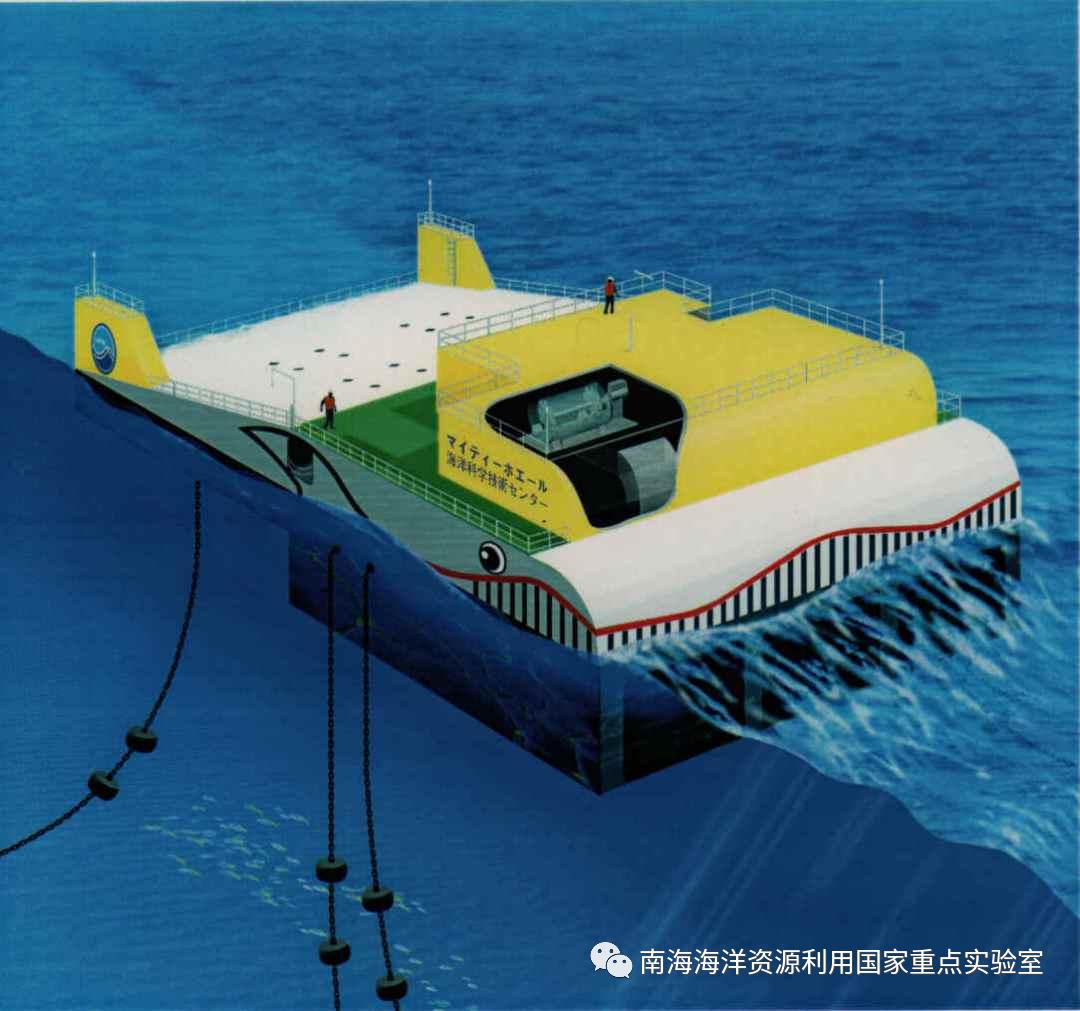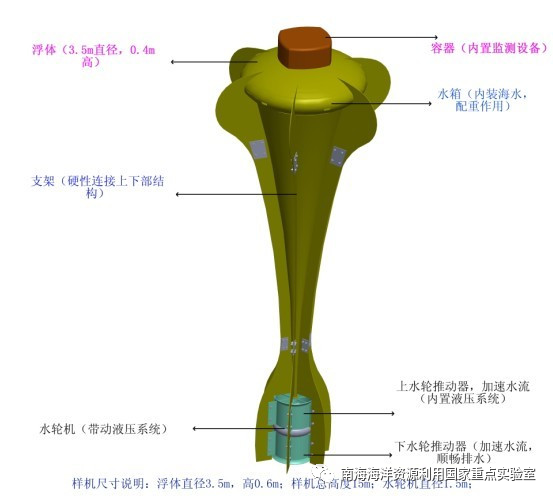海洋能源,通常指海洋中所蕴藏的可再生的自然能源,主要为潮汐能、波浪能、海流能(潮流能)、海水温差能和海水盐差能。更广义的海洋能源还包括海洋上空的风能、海洋表面的太阳能以及海洋生物质能等。按储存形式又可分为机械能、热能和化学能。其中,潮汐能、海流能和波浪能为机械能,海水温差能为热能,海水盐差能为化学能。海洋能是一种具有巨大能量的可再生能源,而且清洁无污染,但地域性强,能量密度低。
Marine energy refers to the renewable natural energy contained in the ocean, mainly including tidal energy, wave energy, current energy (tidal energy), seawater thermal energy and salinity gradient energy. In a broader sense, the marine energy also includes wind energy over the ocean, solar energy on the surface of the ocean and marine biomass energy. According to the form of storage, the marine energy can be further divided into mechanical energy, thermal energy and chemical energy. Among them, tidal energy, current energy and wave energy can be classified into mechanical energy, the seawater temperature difference energy into thermal energy, and salinity gradient energy into chemical energy. Marine energy is a kind of renewable energy with great power, and it is clean and pollution-free, but it is highly localized and has low energy density.

简介
Introduction
海洋占地球表面的71%,以海平面计,全部陆地的平均海拔约为840米,而海洋的平均深度却为380米,整个海水的容积多达1.37亿平方千米。一望无际的汪洋大海,不仅为人类提供航运、水产和丰富的矿藏,而且蕴藏着巨大的能量。
The ocean accounts for 71% of the earth's surface, and the average elevation of all land is about 840 meters above the sea level, while the average depth of the ocean is 380 meters and the volume of the whole seawater is as much as 1.37×10^8 square kilometers. The endless ocean not only provides shipping conditions, aquatic products and rich mineral deposits for human beings, but also contains enormous energy.
浩瀚的大海,不仅蕴藏着丰富的矿产资源,更有真正意义上取之不尽,用之不竭的海洋能源。它既不同于海底所储存的煤、石油、天然气等海底能源资源,也不同于溶于水中的铀、镁、锂、重水等化学能源资源。它有自己独特的方式与形态,就是用潮汐、波浪、海流、温度差、盐度差等方式表达的动能、势能、热能、物理化学能等能源。直接地说就是潮汐能、波浪能、海水温差能、海流能及盐度差能等。这是一种“再生性能源”,永远不会枯竭,也不会造成任何污染。
The vast ocean not only contains rich mineral resources, but also has inexhaustible marine energies in a real sense. It is different from both the coal, oil, natural gas and other submarine energy resources stored under the sea, and is also different from the uranium, magnesium, lithium, heavy water and other chemical energy resources dissolved in water. It has its own unique way and form in that the kinetic energy, potential energy, thermal energy, physical energy and chemical energy are derived from tides, waves, currents, temperature difference, salinity difference, etc. Directly speaking, the energies mentioned above are tidal energy, wave energy, seawater thermal energy, sea current energy and salinity gradient energy. It is a kind of “renewable energy”, which will never be depleted and will not cause any pollution.
海洋能源的特点
Characteristics of Marine Energy
(1) 可再生性:由于海水潮汐、海流和波浪等运动周而复始, 永不休止,海洋能是可再生能源;
(2) 属于一种洁净能源;
(3) 能量多变,具有不稳定性,运用起来比较困难;
(4) 总量巨大,但分布分散、不均, 能流密度低,利用效率不高,经济性差。
(1) Renewability. Marine energy is a kind of renewable source of energy because the tides, currents and waves of the sea never end.
(2) It is a clean energy source.
(3) It is variable and unstable, making it difficult to be utilized.
(4) The total amount of energy is huge, but the distribution is scattered and uneven, and the density of energy flow is low, so the utilization efficiency is not high and the economy is poor.
海洋能源分类
Category of Marine Energy
潮汐能就是潮汐运动时产生的能量,是人类利用最早的海洋动力资源。中国在唐朝沿海地区就出现了利用潮汐来推磨的小作坊。后来,到了11-12世纪,法、英等国也出现了潮汐磨坊。到了二十世纪,潮汐能的魅力达到了高峰,人们开始懂得利用海水上涨下落的潮差能来发电。据估计,全世界的海洋潮汐能约有二十亿多千瓦,每年可发电12400万亿度。
Tidal energy is produced by the tidal movement and is the earliest marine power resource used by human beings. In China, small workshops using tides to push mills appeared in the coastal areas during the Tang Dynasty. Later, in the 11th and 12th centuries, tidal mills also appeared in France and England. By the twentieth century, the fascination of tidal energy reached its peak, and people began to know how to use the energy of the tidal difference between rising and falling to generate electricity. It is estimated that there are about two billion kilowatts of ocean tidal energy in the world, which can generate 12,400 trillion kilowatts of electricity per year.
今天,世界上第一个也是最大的潮汐发电厂就处于法国的英吉利海峡的朗斯河河口,年供电量达5.44亿度。一些专家断言,未来无污染的廉价能源是永恒的潮汐。而另一些专家则着眼于普遍存在的,浮泛在全球潮汐之上的波浪。
Today, the world’s first and largest tidal power plant is located at the mouth of Rance River in the English Channel in France, with an annual power supply of 544 million kilowatts. Some experts assert that the future of pollution-free and cheap energy is the eternal tide, others are looking at the waves that are pervasive and better than tides.
波浪能主要是由风的作用引起的海水沿水平方向周期性运动而产生的能量。波浪能是巨大的,一个巨浪就可以把13吨重的岩石抛出20米高,一个波高5米,波长100米的海浪,在一米长的波峰片上就具有3120千瓦的能量,由此可以想象整个海洋的波浪所具有的能量该是多么惊人。据计算,全球海洋的波浪能达700亿千瓦,可供开发利用的为20-30亿千瓦。每年发电量可达9-万亿度。
Wave energy is primarily generated by the periodic movement of seawater in the horizontal direction caused by the action of the wind. Wave energy is so huge that it can throw 13 tons of rock 20 meters high. A wave with a height of 5 meters and a length of 100 meters has 3120 kilowatts of energy in one-meter-long wave crest piece, so you can imagine how amazing the energy of the entire ocean waves are. According to the calculation, the wave energy of the global ocean reaches 70 billion kilowatts, and the amount available for exploitation is 2-3 billion kilowatts. The annual power generation capacity can reach 9-trillion kilowatts.

除了潮汐与波浪能,海流可以作出贡献,由于海流遍布大洋,纵横交错,川流不息,所以它们蕴藏的能量也是可观的。例如世界上最大的暖流——墨西哥洋流,在流经北欧时为1厘米长海岸线上提供的热量大约相当于燃烧600吨煤的热量。据估算世界上可利用的海流能约为0.5亿千瓦。而且利用海流发电并不复杂。因此要海流作出贡献还是有利可图的事业,当然也是冒险的事业。
In addition to tidal and wave energy, ocean currents are also critical. Since currents are all over the oceans, crisscrossing and flowing, the energy they contain is also considerable. For example, the world’s largest warm current, the Mexican Current, provides approximately the same amount of heat as burning 600 tons of coal along 1 cm of coastline as it flows through northern Europe. It is estimated that the world’s ocean current energy available is about 0.5 billion kilowatts. And it is not complicated to generate electricity from ocean currents. So to utilize ocean currents is still a profitable business, but of course it is also a risky business.
海洋温差能
Ocean Thermal Energy
把温度的差异作为海洋能源的想法倒是很奇妙。这就是海洋温差能,又叫海洋热能。由于海水是一种热容量很大的物质,海洋的体积又如此之大,所以海水容纳的热量是巨大的。这些热能主要来自太阳辐射,另外还有地球内部向海水放出的热量;海水中放射性物质的放热;海流摩擦产生的热,以及其他天体的辐射能,但99.99%来自太阳辐射。因此,海水热能随着海域位置的不同而差别较大。海洋热能是电能的来源之一,可转换为电能的为20亿千瓦。但1881年法国科学家德尔松石首次大胆提出海水发电的设想竟被埋没了近半个世纪,直到1926年,他的学生克劳德才实现了老师的夙愿。
The idea of using the difference in temperature as a marine energy source is quite amazing, which is the so-called ocean thermal energy. Because seawater is a substance with a large heat capacity and the sea is so large, the amount of heat it holds is enormous. This heat energy comes from the following: mainly from solar radiation, some from the interior of the earth, the radioactive substances in seawater, the friction of sea currents, and other celestial bodies, but 99.99% from solar radiation. Therefore, the thermal energy of seawater varies greatly with the location of the sea. Ocean thermal energy is one of the sources of electricity, which can be converted into electrical energy of 2 billion kilowatts. However, the first bold idea of seawater power generation by French scientist Delzonite in 1881 was neglected for nearly half a century until 1926 when his student Claude realized the long-cherished wish of his teacher.
洋能源发展战略
Marine Energy Development Strategy
海洋能源发电在世界各国宏观政策的支持和外部环境的推动及资金的扶持下, 经过多年的科研与试验、开发与利用, 已具备了一定的技术水平和生产基础, 但仍存在着投资大、规小, 获益能力低等问题, 还不具备市场竞争能力。根据海洋能源的发展现状, 为促进我国海洋能的产业化开发, 未来应着重从以下几个方面发展:
With the support of macro policies, external environment and financial support from all over the world, marine energy power generation has achieved a certain level of technology and production foundation after years of scientific research and experiments, development and utilization, but there are still problems such as large investment, small scale and low profitability, and it does not have the ability to compete in the market. According to the current situation of the development of marine energy, in order to promote the industrial development of marine energy, China should focus on the following aspects of development in the future:
(一)海洋新能源开发应统筹规划
应该在深入调查研究的基础上明确海洋新能源的长期发展规划,确定发展重点。我国潮汐能电站目前技术比较成熟,但是面临海岸线紧缺、潮差不够大等先天资源不足以及与港口、交通运输和海洋渔业的矛盾突出、社会综合效益不足等难题,自然和社会两方面因素限制了我国潮汐能电站的规模化发展前景。
ⅰ The development of new marine energy should be planned after careful consideration
On the basis of in-depth investigation and research, the long-term development plan of new marine energy should be clarified and the development focus should be determined. China’s tidal energy power station technology is relatively mature now, but facing the shortage of shoreline and small tidal difference and other inherent resource deficiencies, the conflicts in the fields of the port, transportation and marine fisheries, as well as the lack of comprehensive social benefits and other challenges, both natural and social factors limit the scale of China’s tidal energy power station development prospects.
(二)海洋油气业安全应急需跟上
中国深海油气业在与外资合作开发国能海洋油气资源的同时,也主动与别国开采国外的石油资源,但是总体来说,中国深海资源开发方面的国际程度仍然较低。未形成大规模、全方位的国际合作趋势。
ⅱ The safety of the marine oil and gas industry should urgently improve
While China’s deep-sea oil and gas industry is in cooperation with foreign investors to develop marine oil and gas resources, it also takes the initiative to exploit foreign oil resources with other countries. Generally speaking, China’s internationalization in the development of deep-sea resources is still relatively low, and the trend of large-scale and all-round international cooperation has not been formed.
(三)海洋能源开发需海洋权益安全保障
海洋能源开发离不开海洋政策、海洋管理、海洋法律体系、海洋权益等多方面的保障。在国家层面,海洋发展的趋势是促进跨部门、跨行业、跨学科的海洋和海岸带综合管理机制,以整合各行业、各部门的涉海规划和活动。专家认为,尤其要重视海洋权益安全对海洋能源开发的保障作用。
ⅲ Marine energy development needs security guarantee of marine rights and interests
Marine energy development cannot be separated from the protection of ocean policy, ocean management, ocean legal system, ocean rights and interests, and other aspects. At the national level, the trend of ocean development is to promote an interdepartmental, cross-industry and interdisciplinary mechanism for integrated ocean and coastal zone management in order to integrate the ocean-related planning and activities of various industries and sectors. Experts believe that particular attention should be paid to the role of marine rights and security in safeguarding marine energy development.
(四) 海洋能源科研体制亟待创新
家医药管理数海洋新能源的利用方式尚处于基础研究阶段,我国海洋能开发研究机制还不适合海洋能开发的客观现实,存在宏观政策不稳定、国家投资强度不够、研究队伍水平不高、评价机制不科学等问题。
iv Marine energy research system needs urgent innovation
The research of new marine energy utilization channel is still in the basic research stage. China’s marine energy development faces the following deficiencies: research mechanism is not yet suitable for the objective reality of marine energy development; instable macro policy; national investment intensity is not enough; the quality of the research team is not high; the evaluation mechanism is not scientific.
参考资料
[1] 王新,周艳艳,郑天凌. 海洋细菌生态学的若干前沿课题及其研究新进展[J]. 微生物学报,2010,50(03):291-297.
[2] 马聪,陈昌国,蒋学兵,李丹丹,刘敏,郝秀红,马学斌,钱扬会. 中国海域海洋细菌分布特征分析[J]. 解放军医学杂志,2012,37(09):909-913.
 公众号
公众号